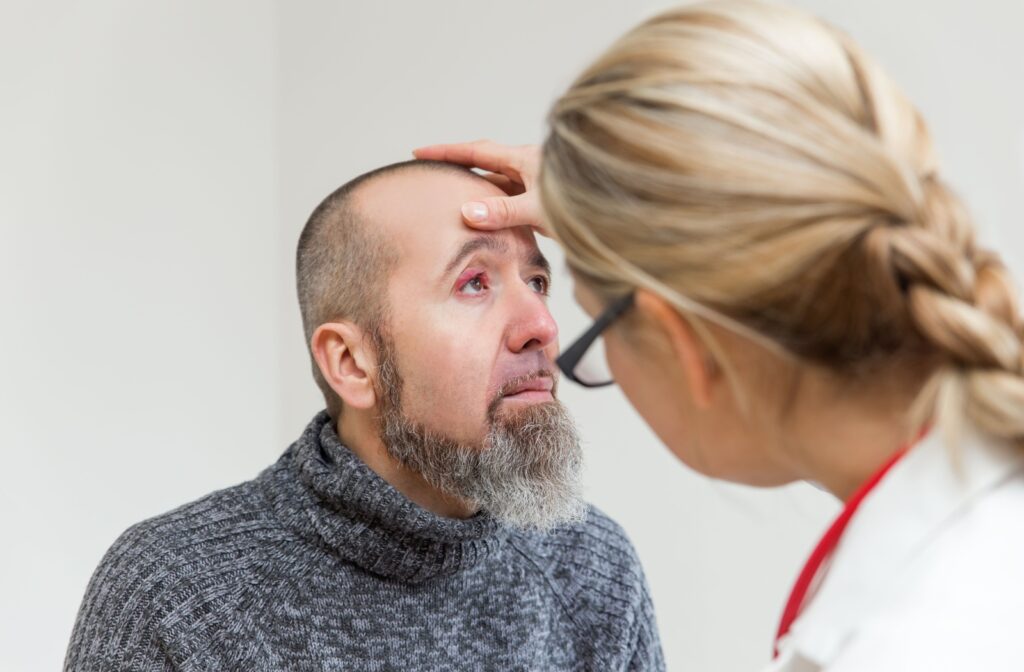Styes are a much more common eye condition than most people think. These small, red, tender bumps often develop due to a bacterial infection and can be irritating to deal with alone. Fortunately, your optometrist can help you treat the affected area to find relief. However, some people experience recurring styes, which can be extremely frustrating.
Recurring styes develop when you don’t practice proper eye hygiene, re-use old makeup, hormonal fluctuations, and more. If you constantly experience red bumps on your eyelids, visit your optometrist; they can help provide a proper diagnosis and advise you on preventing styes in the future.
What Are Styes?
A stye, also known as a hordeolum, is a red, irritating bump on the inner or outer eyelid. It’s basically a localized infection of follicles or glands around the eye, which can develop on the inside or outside of the eye.
When bacteria reach these sensitive follicles and glands, they can multiply. This worsens if there’s a blockage or plug; it creates a small sealed area where bacteria can thrive. Then, this infection can become more severe, eventually causing inflammation and irritation.
While styes aren’t inherently dangerous, they can be extremely irritating and visually displeasing. They can also harden over time, becoming a “chalazion.”
If you think you have a stye, it’s crucial that you avoid trying to pop or drain it yourself. Though this seems like it would solve the problem, it actually does the opposite—popping a stye spreads bacteria further around the eye and can lead to an eye infection.
Common Causes of Styes
So, what can cause this bacterial buildup in the first place? There are a few common culprits:
- Poor eye hygiene: Not cleaning your eyelids regularly or touching your eyes with dirty hands can introduce bacteria and lead to recurring styes.
- Makeup: Using old or contaminated makeup, especially eye makeup, can irritate the eye and cause styes to form.
- Stress: Stress can weaken your immune system and make you more susceptible to infections like styes.
- Hormonal changes: Hormonal fluctuations, especially during menstruation or pregnancy, can increase the risk of developing styes.
- Other eye conditions: Blepharitis, where bacteria cause inflammation around the edge of the eyelids, can also cause a stye.
If you leave any of these factors unaddressed, a stye may not be a one-time thing. For example, regularly using expired makeup continuously exposes your eye to the same bacteria that caused an infection in the first place. This can lead to recurring styes.
It’s essential to learn how to recognize the signs of a stye. The bacteria can cause a great deal of irritation and inflammation, and learning to recognize a stye is the first step towards finding relief.
How to Recognize a Stye
To recognize a stye, try to keep a close eye on any visible changes on your eyelids. Styes usually appear like a small pimple—a small red dot poking through the skin. Because of this, they can easily be mistaken for regular acne, so try to keep an eye out for other signs that it’s a stye, such as:
- Swelling and tenderness around the eye
- Crusting or discharge from the eye
- Sensitivity to light
- A feeling of grittiness or scratchiness in the eye
- Excessive tearing
You may have a stye if you’re experiencing any of these symptoms. Don’t worry, though—there’s no need to panic!

Can an Optometrist Cure a Stye?
If you think you have a stye, it’s time to visit your optometrist. Remember—don’t try to pop or release it on your own! Instead, let a professional address the problem.
When you visit your optometrist about a stye, they can confirm exactly what it is and recommend the right approach to reduce your symptoms. Typically, this can be done through antibiotics, but they may be able to drain it in-office.
They also may be able to determine exactly what’s causing your stye. For example, if it’s developing due to a condition like blepharitis, they’ll be able to advise you on effectively cleaning the areas around your eyes. This can help prevent bacterial buildup and keep your eyes healthier.
Tips for Preventing Styes
When it comes to conditions like styes, there is good news—by practicing proper hygiene at home, you can significantly reduce the odds of developing a stye.
Here are some simple tips to keep your eyes healthy and stye-free:
- Clean your eyelids regularly with a mild soap and lukewarm water.
- Replace makeup regularly, especially around the eyes. Old makeup containers can be breeding grounds for bacteria that can easily spread to the eyes.
- Follow a healthy diet rich in vitamins and nutrients to strengthen your immune system.
- Avoid touching, rubbing, or scratching your eyes whenever possible, especially if your hands aren’t clean. Always wash your hands before and after touching your eyes.
These simple steps can effectively prevent styes and other bacterial infections in the eye.
When to See Your Optometrist
If you think you have a stye, don’t try to deal with it alone; instead, come talk to us at Camarillo Vision Center.
Our team can diagnose your condition and help you find the right approach to treating it. We’re here to keep your eyes healthy and safe, so book an appointment with us today!



